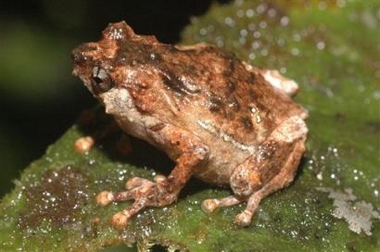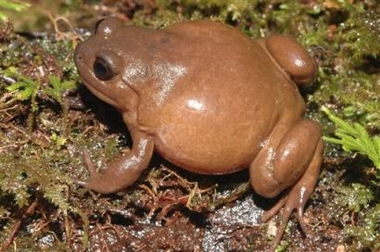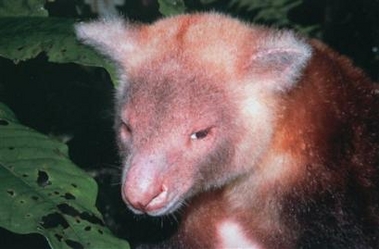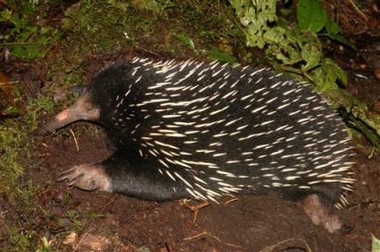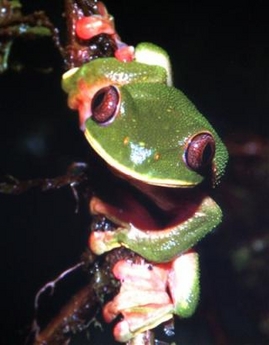Scientists discover dozens of new species in New Guinea
Conservation International release
February 6, 2006
EDITOR’s NOTE: A team of scientists led by Conservation International (CI) found dozens of new species in a survey of New Guinea’s Foja Mountains. The discoveries were made under CI’s Rapid Assessment Program (RAP) which deploys expert scientists to poorly understood regions in order to quickly assess the biological diversity of an area. The conservation organization makes RAP results immediately available to local and international decision makers to help support conservation action and biodiversity protection. New Guinea’s forests are some of the most biodiverse in the world, but they are increasingly under threat from commercial logging.
An expedition to one of Asia’s most isolated jungles — in the mist-shrouded Foja Mountains of western New Guinea — discovered a virtual ”Lost World” of new species, giant flowers, and rare wildlife that was unafraid of humans.
The December 2005 trip by a team of U.S., Indonesian, and Australian scientists led by Conservation International (CI) found dozens of new species including frogs, butterflies, plants, and an orange-faced honeyeater, the first new bird from the island of New Guinea in more than 60 years.
Conservation International and the Indonesian Institute of Science (LIPI) sponsored the expedition, with financial support from the Swift Foundation, the Gordon and Betty Moore Foundation, the National Geographic Society and the Global Environment Project Institute.
The team captured the first photos ever seen of exotic birds such as a male Berlepsch’s Six-Wired Bird of Paradise (Parotia berlepschi). It also found a new large mammal for Indonesia — the Golden-mantled Tree Kangaroo (Dendrolagus pulcherrimus), formerly known from only a single mountain in neighboring Papua New Guinea.
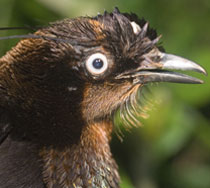 © CI, Bruce Beehler Berlepsch’s Six-wired Bird of Paradise (Parotia berlepschi) is named for the curious wires that extend from its head in place of a crest. RELATED ARTICLES In search of Bigfoot, scientists may uncover unknown biodiversity in Malaysia 02/01/2006 Malaysian scientists are scouring the rainforests of Johor state in search of the legendary ape-man Bigfoot, supposedly sighted late last year. But they are more likely to encounter some less fantastic but unique creatures that dwell in these still unexplored ecosystems. |
“It’s as close to the Garden of Eden as you’re going to find on Earth,” marveled Bruce Beehler, vice president of CI’s Melanesia Center for Biodiversity Conservation and a co-leader of the expedition. “The first bird we saw at our camp was a new species. Large mammals that have been hunted to near extinction elsewhere were here in abundance. We were able to simply pick up two Long-Beaked Echidnas, a primitive egg-laying mammal that is little known.”
The discoveries solved one major ornithological mystery — the location of the homeland of Berlepsch’s Six-Wired Bird of Paradise. First described in the late 19th century through specimens collected by indigenous hunters from an unknown location on New Guinea, the species had been the focus of several subsequent expeditions that failed to find it.
On the second day of the recent month-long expedition, amazed scientists watched as a male Berlepsch’s bird of paradise performed a mating dance for an attending female in the field camp. This was the first time a live male of the species had been observed by Western scientists, and proved that the Foja Mountains was the species’ true home.
The expedition took place almost 25 years after Jared Diamond startled the scientific world in 1981 with his discovery of the forest homeland of the Golden-fronted Bowerbird in the same mountain range. This time, scientists captured the first photographs ever of the Golden-fronted Bowerbird displaying at its bower — a tower of twigs and other forest materials it builds for the mating ritual.
The new species of honeyeater, the first new bird discovered on the island of New Guinea since 1939, has a bright orange face-patch with a pendant wattle under each eye. Other discoveries included what may be the largest rhododendron flower on record — almost six inches across — along with more than 20 new frogs and four new butterflies.
Local Kwerba and Papasena people, customary landowners of the forest, welcomed the Conservation International team and served as guides and naturalists on the expedition into the vast jungle tract. These people told the team that game was hunted in abundance within an hour’s walk of the village.
Such abundance of food and other resources means the mountain range’s interior — more than 300,000 hectares of old growth tropical forest — remains untouched by humans, and the entire Foja forest tract of more than 1 million hectares constitutes the largest essentially pristine tropical forest in Asia and an important region for biodiversity conservation.
More pictures from Conservation International:
This is a modified news release from Conservation Interational.
